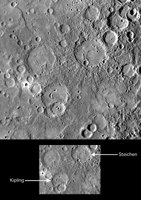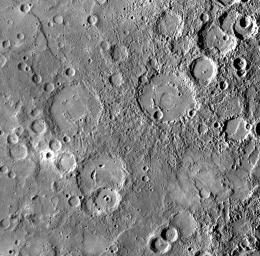
Click on the image for larger versionThe neighboring craters Kipling and Steichen, named in March 2010, both feature smooth floors, as do other large craters in this image. Also visible on the floor of Steichen are remnants of a peak-ring structure, seen as low mountains poking up above the smooth floor material. The floor of Kipling shows an oblong "yam-shaped" pit, similar in appearance to pit craters seen on some other crater floors. Pits such as this one (and possibly the ones visible within the floor of the overlapping crater to Kipling's south) may have formed as a result of the eruption or lateral movement of subsurface magma, leading to the collapse of the roof of the magma body. The crater floors may be smooth because they were flooded by lava or, alternatively, the smoothness may be due to emplacement of impact melt. From MESSENGER's flyby images alone, it is difficult to decide on the relative contributions of these alternative processes to these craters, but higher-resolution and color images planned for next year's orbital mission along with topographic and spectral measurements will enable a better understanding of why the floors of Kipling and Steichen appear as they do. Steichen was named for Edward Steichen (1879-1973), an American photographer and painter. Kipling's name was chosen in honor of Rudyard Kipling (1865-1936), an English author best known for The Jungle Book.
Date: September 29, 2009
Instrument: Narrow Angle Camera (NAC) of the Mercury Dual Imaging System (MDIS)
Resolution: 500 meters/pixel (0.31 miles/pixel)
Scale: Steichen is 159 kilometers (99 miles) in diameter; Kipling is 151 kilometers (94 miles) in diameter.
Projection: This image is a portion of the NAC approach mosaic from Mercury flyby 3. It is shown in a simple cylindrical map projection.
These images are from MESSENGER, a NASA Discovery mission to conduct the first orbital study of the innermost planet, Mercury. For information regarding the use of images, see the MESSENGER image use policy.

 Planetary Data System
Planetary Data System













